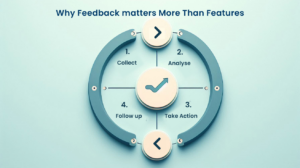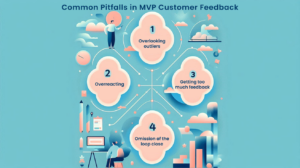Introduction
The initial goal of startups in building their initial product is validation rather than perfection. The development of a Minimum Viable Product (MVP) represents the core component of this business approach. The product release focuses on bringing a simplified version which contains necessary features to interest initial adopters and gather audience insights. The essential function of user feedback during product development and how effective MVP customer support directly impacts product transformation becomes easily disregarded by many companies.
The act of providing feedback should not be treated as an afterthought that comes only after the launch. The development cycle of iterative products relies on user feedback specifically in the case of Minimum Viable Products (MVPs). The success of new ventures that start by focusing on MVP customer care from the first day leads to creating products that target genuine consumer wants.
Why Feedback Matters More Than Features

In the early stages of building a product, there’s a strong temptation to load up on features. Founders often believe that more functionality equals more value. But MVP development turns this thinking on its head. The whole point is to strip a product down to its most essential features and put it in front of users as quickly as possible.
So what fills the gap left by all the missing bells and whistles? Insight. Specifically, insight that comes directly from the user.
Think of your MVP not as a final product, but as a learning tool. Every user interaction is a clue. Every bug report, suggestion, or even complaint is a data point that can guide development in the right direction. And to capture those data points, you need a solid MVP customer service strategy in place.
The Feedback Loop: A Startup’s Secret Weapon
Listening well is a trick to get successful startups. They run a continuous loop of listening, learning and iterating. So here’s the picture of a healthy feedback loop while developing an MVP:
– Launch the MVP product
– MVP or minimum viable product customer care channels should collect feedback from customers.
– Look to the feedback for patterns and an understanding.
– Implement necessary changes
– Re-release the updated product
– Repeat
Every cycle increases the product’s focus, and guarantees that it changes throughout real user behavior, not guess work. The sad truth of the matter is that it can’t be done efficiently without taking priority customer service for their MVPs as a starting point to acquisition. Feedback collection is not just about collecting feedback, but getting involved with users, understanding what they need and act on it immediately.
A good MVP customer care creates trust, encourages people to participate, and supports the discovery of things that the development phase didn’t bring much focus to. This means that startups can keep in constant touch with early adopters and get a strategic advantage for their MVP product: not only is the product functional, but it’s seen as valuable in the eyes of its users.
Building a Feedback-Friendly MVP
Now the big question: How do you encourage users to give feedback on your MVP in the first place?
It starts with making feedback easy, accessible, and valued. Here are some best practices:
– In-app feedback forms: Simple pop-ups asking “How are we doing?” go a long way.
– User surveys: Keep them short and targeted—nobody wants to fill out a 20-question form.
– Customer support chats: Real-time conversations offer rich, qualitative feedback.
– Social media listening: Sometimes, users won’t come to you—they’ll talk about you. Be there to listen.
– Analytics tools: Track what users do, not just what they say. Usage data tells its own story.
And don’t just collect feedback—acknowledge it. A quick follow-up email saying “Thanks, we’re working on it!” makes users feel heard. That’s the foundation of good MVP customer care.
The Emotional Side of MVP Customer Service
Most of us think about MVP development as cold, hard terms. Build fast, fail fast, iterate. The truth is however, that customers don’t give a damn that you’re ‘still figuring it out’.. Even when they’re communicating with a half built product, they want to feel respected.
Strong MVP customer service is a competitive edge there. A membership you give to your support team will go such a long way to the way a user feels about a bug or missing feature: how they interact with the product, etc. It turns frustration into loyalty.
A small thing like, “We know this isn’t perfect, and we’re thankful for your patience as we fix it” can still go a long way. Human connections matter—even in MVPs.
Turning Feedback Into Roadmap Gold
Getting feedback is only 50% of the challenge. You must also know how to manage it. Not all feedback created is equal. The technique is to find patterns. If 50% of people voted on the same improvement, then that’s a roadmap.
Here’s how to prioritize feedback:
– Occurrence: How often the problem is mentioned.
– Severity: Can it add to the abandonment of users from even delivering primary functions?
– Alignment: Is it consistent with your vision for the MVP product?
– Effort vs. Impact: Is this a low-hanging rough in regards to impact?
In addition to just filtering the feedback, it’s necessary to maintain a feedback repository where insights are annotated and frequently revisited. Trends may not be apparent at first, but as the months pass, trends become visible and give rise to long-standing strategy. And also never disregard user recommendations from your core value proposition. It can become simple to pursue every request, but keeping your focus on your mission guarantees that your MVP grows with intention. By relating product roadmaps to actual client requirements, you’ll improve a product that influences—and ignore unrequested attributes.
How to Structure a Feedback-Driven MVP Team
Here’s a basic structure:
– Customer Success Lead: Owns the user communication pipeline.
– Product Manager: Translates feedback into actionable items.
So, insights are not just in TypeForm or Google Sheet but in fact also drive MVP products. If the feedback loop is going to be effective, each and everybody in the team must have a clear understanding of what their task is. For this, the Customer Success Lead continuously tried to open the communication channels, the Product Manager absorbed the raw input and devised an ambitious roadmap, and the Developers chose what to fix first. QA audits to ensure that new releases are inline with real user expectations, that is, minimizing bugs. Data Analysts can unveil less visible patterns hidden by the sheer volume of feedback and enable you to make the most intelligent decision in a lot less time. This architecture lets the MVP grow with accuracy and direction combined.
Common Pitfalls in MVP Customer Feedback

Even good-willed start-ups can blunder with feedback. One of these to look out for are:
– Overlooking outliers: Feedback is unusual so such isn’t wrong. Frequently your early adopters notice something others miss.
– Overreacting: Rarely alter a whole product due to two or three nuts.
– Getting too much feedback: If you’re overwhelmed with ideas, it may be the moment to narrow down your concentration.
– Omission of the loop close: Never leave the user wondering what you did with his feedback. That’s how trust is built.
Steering clear of these pitfalls, MVP customer service can morph from an extra weight into a highly competitive asset.
Feedback Isn’t the End—It’s the Beginning
The privilege of feedback as the last step can create an impression that we build, they use, they comment, which streamlines our interface with the previous implementation. However, in reality, feedback is the beginning of the next development cycle. It gives you a guide, a path to follow, a route to go next, and what you are going to tweak and should double down on. Every feedback is incremental to a product that not just works but feels right to the people using it.
However, users are more prone to stick around when they feel involved in the process. So that’s the real value of thoughtful MVP customer care, it’s not about getting customers, it’s about creating co-creators. Users see their suggestions to your team reflected in what updates look like or they feel heard, so they come to rely on and feel that they are your partner in creating what the updates will look like and whether it’s what they want them to look like. Emotionally, this investment is invaluable, it’s what causes casual users to turn into advocates and beta testers to become long-time supporters. In fact, feedback isn’t a means to improve your MVP product but rather a tool to reach a community.
Frequently Asked Questions
1. What is MVP customer service and why is it important?
MVP customer service is the strategies used during the MVP launch and development of a minimum viable product. It’s important because early users are an important source of feedback that will in turn inform the evolution of the product into a finished product. A good MVP customer service leads people to feel heard and valued; therefore they feel it is in their best interest to share the insights on how to make a product better.
2. How does user feedback influence an MVP product?
Feedback from users allows startups to know which feature works and which one does not, and also what the customer really needs. This helps the team refine the MVP product based on actual user behaviour and also about the preferences not assumptions.
3. What are the best ways to collect feedback during MVP development?
There are several things you can use to determine if your in-app surveys are working—such as in-app surveys, live chat support, user interviews, email follow ups and much more. It creates open MVP customer care channels, increasing the amount and quality of feedback you have after your MVP.
4. How do I prioritize customer feedback for MVP improvements?
First, spot the common themes or problems; then, how to assess feedback according to frequency, seriousness, alignment to your product vision and the work involved to change its perspective. This allows you to not just build extra value into your MVP, which isn’t a bad thing, but to do it in a way that only adds incremental work onto your team.
Final Thoughts: Feedback as Fuel for MVP Growth
Building the app is simply the first step in launching an MVP that leads to something bigger. That foundation is only as solid as the feedback it has been built on.
If you can force your employees to follow strong MVP customer service practices into your startup culture from the start, you’ll be on the quickest way to creating better, faster, and smarter. Luckily, either through real time chats, user surveys or good old fashioned email conversations, it makes it easy to stay in line with your audience, and ensures that your MVP product isn’t being sidetracked.
So don’t just build. Listen. Learn. Adapt. That’s the MVP mindset and that’s how user feedback is YOUR GREATEST GROWTH ENGINE.
Do you like to read more educational content? Read our blogs at Cloudastra Technologies or contact us for business enquiry at Cloudastra Contact Us.